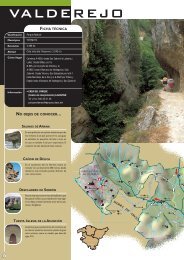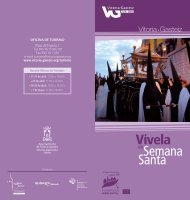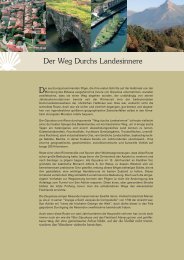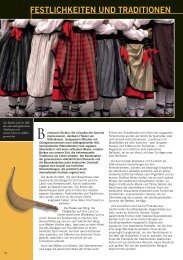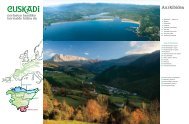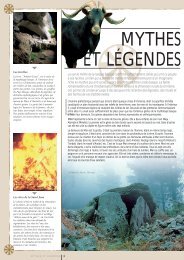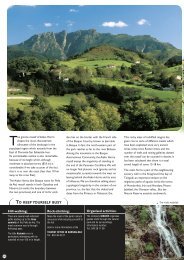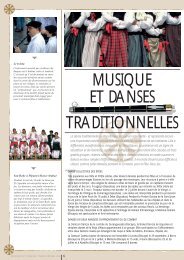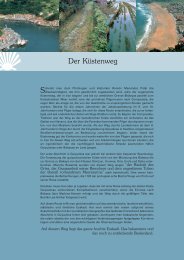TRADITIONAL CULTURE - Euskadi
TRADITIONAL CULTURE - Euskadi
TRADITIONAL CULTURE - Euskadi
You also want an ePaper? Increase the reach of your titles
YUMPU automatically turns print PDFs into web optimized ePapers that Google loves.
<strong>TRADITIONAL</strong> <strong>CULTURE</strong><br />
The Basque Country is the past, the present and the future. Tradition and avantgarde.<br />
The diversity of this land, the importance of its roots and the will to progress<br />
of the local population, have given shape to a society in which traditional ways of<br />
life and customs rub shoulders with the latest in modern artistic, cultural and<br />
architectural expressions.<br />
The unique orography of the Basque country, characterised by valleys with difficult access, has<br />
permitted the conservation of a strong popular culture, bursting with myths and legends,<br />
customs, rites and folklore, and enabled the preservation of the language of the Basque people,<br />
Euskera, the origins of which are unknown.<br />
Today these traditions are remembered at the fiestas celebrated throughout the year. In autumn,<br />
winter, spring or summer, the capitals and villages of the Basque Country throw themselves into<br />
their festivities heart and soul. Religious or pagan, these events bring the locals together in<br />
multitudes, adding spice to the calendar while commemorating historic facts and honouring<br />
their saints and patron saints.<br />
One picturesque expression of Basque tradition are the rural sports,<br />
reflection of the everyday chores of the ancient Basques.<br />
The harrijasotzailes (stone-lifters), segalaris (grass-cutters),<br />
or aizkolaris (woodcutters) emulate the work done by the<br />
inhabitants of the baserri (farmhouse). Basque pelota or<br />
the fixed-thwart rowing boat competitions, the most popular<br />
traditional Basque sports, thrill lovers of these events and move a fortune in bets.<br />
Although the Basque Country has preserved the wealth of its folklore down through<br />
the ages, it has also succeeded in complementing its customs and traditions with the<br />
strong culture of innovation present in the actions that now mark the future of the<br />
Basque people. The Basque Country means avant-garde, a factor especially reflected in<br />
1 st Edition: April 2002.<br />
8 th Edition: November 2007<br />
Published by:<br />
Eusko Jaurlaritzaren Argitalpen Zerbitzu Nagusia<br />
Servicio Central de Publicaciones del Gobierno Vasco<br />
Designed and Produced by: ACC Comunicación<br />
Texts written by: Kultur Web, Idazti<br />
Translations by: Bitez, S.L.<br />
Photographs by: Javier Carballo, Javier Juanes, Agustín<br />
Sagasti, Emilio Javier Dueñas, Lurrak.<br />
Printed by: Gráficas Santamaría, S.A.<br />
D.L.: VI-542/07<br />
© Administration of the Autonomous Community of the Basque<br />
Country, Department of Industry, Commerce and Tourism.<br />
Data updated to September 2007<br />
The partial and/or total reproduction of the text, maps or<br />
pictures included in this guide without the prior authorization<br />
of this Department, and of its authors, is prohibited.<br />
6<br />
Page Page Page<br />
MYTHS AND<br />
<strong>TRADITIONAL</strong><br />
FIESTAS<br />
LEGENDS<br />
DANCES AND<br />
• Winter fiestas<br />
MUSIC<br />
EUSKARA<br />
• Easter and<br />
springtime<br />
• Summer<br />
fiestas<br />
4 8
AND AVANT-GARDE<br />
its art and culture. The impressive Guggenheim never fails<br />
to amaze, even after several visits. The Bilbao Museum of Fine and<br />
Modern Art boasts one of the biggest painting collections in Spain. The Basque Museum of<br />
Contemporary Art-Artium Museum of Alava exhibits a selection of one<br />
of today's most complete, unique and dynamic collections of contemporary<br />
Spanish art. Chillida-Leku takes a novel look at the integration of art with<br />
nature and the human being, and the San Sebastian Aquarium houses<br />
an oceanarium wich is the only one of its kind in Europe. The Kursaal<br />
and Euskalduna Conference Centres, home of numerous fairs and events,<br />
are exponents of this architectural innovation, and contribute to taking<br />
the name of this land all over the world.<br />
But it’s not only these singular constructions figuring among the most important in world<br />
architecture that reflect the ground-breaking spirit of the Basques. This land’s desire for innovation<br />
is also present in the technology parks with their state-of-the-art companies. And in each of<br />
the works of art to be found both in and outside of the different Basque museums. The streets<br />
and parks sport unique creations including the Peine del Viento in Donostia-San Sebastián, the<br />
Plaza de los Fueros in Vitoria-Gasteiz, or the Parque de los Pueblos de Europa in Gernika. Chillida,<br />
Oteiza, Ibarrola or Basterretxea have enhanced the wealth of the Basque territory with their<br />
marvellous works. It is not, however, only these famous names who place the Basque Country<br />
at the forefront, but all of those who dedicate their creative spirit to bettering this land.<br />
And that’s why the Basque Country is yesterday, today<br />
and, above all tomorrow. Faithful to its traditions, the<br />
Basque Country, open to Europe and to the world, strides<br />
towards the future marking out its destination with<br />
every step. That’s the Basque Country, a land of contrast<br />
and integration, of tradition and avant-garde.<br />
14 16 20 26 28<br />
Page Page Page Page Page<br />
RURAL SPORTS<br />
21 st CENTURY<br />
CATHEDRALS<br />
MUSEUMS<br />
THE MOST<br />
INTERESTING<br />
<strong>TRADITIONAL</strong><br />
FIESTAS AND<br />
FESTIVALS<br />
ADDITIONAL<br />
INFORMATION<br />
TOURIST<br />
INFORMATION



